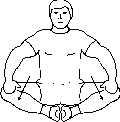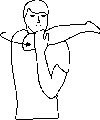These soccer stretching exercises will not only increase your flexibility…
They also have a positive effect on your ability to perform ball skills and your agility around the pitch…
A good range of motion helps you to perform fine motor skills with greater poise, elegance and consistency. It also improves your agility – aiding you in quick changes in direction and speed off the mark.
But to gain the benefits from a soccer stretching program you must make more than a token effort at the end of a cool down.
This article covers how you can increase your range of motion with just 3-4 short, sessions a week. And yes, you can still perform them at the end of your trainingto save time…
Different Types of Flexibility
Broadly speaking there are 3 types of flexibility. One is more relevant to soccer than the other two…
Static Active flexibility
Your ability to stretch an antagonist muscle using only the tension in the agonist muscle. An example is holding one leg straight out in front of you as high as possible. The hamstring (antagonist) is being stretched while the quadriceps and hip flexors (agonists) are holding your leg up.
Static Passive flexibility
Your ability to hold a stretch using your body weight or some other external force. Using the example above imagine holding your leg out in font of you and resting it on a chair. Your quadriceps is not required to hold the extended position.
Dynamic flexibility
Your ability to perform a variety of movements within the full range of motion about a joint. An example is swinging a leg back and forth as if to kick an imaginary ball.
Guess which is most relevant to soccer?
Yep, dynamic flexibility, although the other two play an important role.
In order to increase your range of motion and flexibility, there are number of stretching methods you can use. Some are better (and safer) than others. Here is a brief outline…
For Soccer Players & Coaches of All Ages: Significantly improve your own (or your team’s) performance and consistency on the pitch. My complete guide to professional-level soccer conditioning will show you how to beat the competition at any level.
Different Types of Soccer Stretching
- Dynamic soccer stretching – often used at the beginning of a warm up. Making circles with the arms to loosen the shoulders, twisting from side to side and swing each leg as if to kick a ball are all good examples.
- Ballistic soccer stretching – bouncing or ‘jerky’ movements that use your bodyweight to increase the stretch. Bending over and bouncing to touch your toes is a classic example. Avoid ballistic stretching. There are safer and equally as effective ways to improve range of motion.
- Static soccer stretching – muscles are stretched without moving the limb or joint itself. A good example of a static stretch is the traditional quad stretch where, standing on one leg, you grab your ankle and pull your heel into your backside.
There are other more advanced forms of stretching – PNF, CRAC and isometric stretching. They are a bit more intense but can be very effective. We’ll stick to static stretches for now. With that said let’s move on to a soccer stretching program…
Soccer Stretching Program
Stretching to increase flexibility rather than as part of a warm up requires a slightly different approach…
Each stretch should be held for 20-30 seconds and should be repeated at least twice (preferably three time). So for example, you wouldn’t perform a calf stretch, then a hamstring stretch then a quad stretch etc., and then repeat the whole routine.
Instead you would perform 3 calf stretches, then 3 hamstring stretches and so on.
Don’t perform a soccer stretching routine designed to increase flexibility at the start of a training session or a game…
Some studies suggest it can decrease power and hinder performance. This is NOT the same as stretching as part of a warm up – where stretches are held for shorter periods and are not performed back to back – you should always stretch during a warm up.
Here are some other general, but important guidelines to bear in mind before you start your soccer stretching routine…
- Do NOT hold a stretch that is in anyway painful. It should feel tight and that tightness should diminish as you hold the stretch.
- Breath! Avoid breathing holding as you stretch as this can raise blood pressure and leave you feeling dizzy.
- For optimal results try to stretch every day or at least 3-4 times a week
- Makes sure your body in completely warm before you start. Either do 5-10mins of light aerobic exercise or do your stretches at the end of a training session.
- Hold each stretch for 20-30 seconds. “Shake out” the limb and joint and repeat for a total of 2 to 3 sets.
- Don’t expect results overnight. It can take up to 6 weeks to see measurable improvements. Be persistent – they will come.
- Finally, consider testing yourself prior to starting a soccer stretching program then again after 6 weeks. See the flexibility tests page for more information.

Two Leg Hamstring Stretch
- With both feet together and legs fully extended, reach forward with both hands towards your toes.
- Tuck your chin towards your chest to increase the stretch. 3. Keep your toes pointed towards the sky.

Hamstring Split Stretch
- Bending on one knee, extend the other leg out in front of you.
- Reach with both hands towards your outstretched foot.
- Keep your toes towards the sky and tuck your head to increase the stretch. Remember to breathe!
- Repeat for the opposite side.

Lying Quadriceps Stretch
- Lying on one side grasp your ankle and pull your heel towards your buttocks.
- Keep your back straight and the other leg bent.
- Do not grab your foot. Grab just above the ankle joint (the bottom of your leg).
- Keep the thigh in line with your body. To increase the stretch push your hips forward (only a slight movement).
- Repeat for the opposite side.

Classic Quadriceps Stretch
- Standing one leg, grab your opposite ankle and pull your heel into your buttocks.
- Your bent knee should sty parallel with your standing leg rather then being pulled behind.
- Push your hips out to increase the stretch and remember not to grab the ankle joint.
- Repeat for the opposite side.

Standing Groin Stretch
- Stand with your legs wider than shoulder width apart.
- Shift your weight onto one side as you bend your knee.
- Reach with one hand towards your outstretched foot.
- You should feel the stretch right down the inside of your outstretched leg.
- Repeat for the opposite side.

Sitting Groin Stretch
- Sit with knees bent at 90 degrees.
- Place the soles of your feet together to ‘splay’ your knees outwards.
- Gently use your hands or elbows to push your knees downwards.

Lower Back Stretch
- Sit with the legs straight out in front of you.
- Bend the right knee so the sole of your foot is flat on the ground.
- Turn your upper body towards your right knee and place your right hand on the floor for support.
- Place your left forearm on the outside of your right knee and gently pull your knee towards you.
- Resist with your knee and left hand to feel the tension in your lower back.
- Repeat for the opposite side.

Standing Calf Stretch
- Using a wall or bar to support you, place one leg outstretched behind you.
- Keeping the other leg bent lean against the wall to apply pressure to your beg leg.
- Make sure you keep your back heel flat on the ground.
- Repeat for the opposite side.

Chest & Back Stretch
- This stretch can be performed kneeling or standing. Take your boots off if you kneel.
- Clasp your hands behind your back, keeping your arms as straight as possible.
- Try to straighten your arms and raise them.
- From this position bend forward from the waist also tucking your head towards your chest.
- Hold this position for the recommended amount of time.

Shoulder Stretch
- Place one are outstretched across your chest.
- Place the hand or forearm of your other arm on your outstretched elbow to apply pressure.
- Gently pull your outstretched arm closer to your chest, keeping it as straight as possible.
These soccer stretching exercises are in this order for a reason. However, change it to suit your needs and also add in some extra stretches as you see fit.
The main consideration is to perform several sets back to back and to hold the stretches for at least 20-30 seconds.

Jacky has a degree in Sports Science and is a Certified Sports and Conditioning Coach. He has also worked with clients around the world as a personal trainer.
He has been fortunate enough to work with a wide range of people from very different ends of the fitness spectrum. Through promoting positive health changes with diet and exercise, he has helped patients recover from aging-related and other otherwise debilitating diseases.
He spends most of his time these days writing fitness-related content of some form or another. He still likes to work with people on a one-to-one basis – he just doesn’t get up at 5am to see clients anymore.
